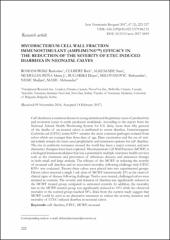Mycobacterium cell wall fraction immunostimulant (Amplimune™) efficacy in the reduction of the severity of etec induced diarrhea in neonatal calves

View/
Date
2017Author
Romanowski, Radoslaw
Culbert, Rick
Alkemade, Stan
Medellin-Peńa, Maira
Bugarski, Dejan
Milovanović, Aleksandar
Nešić, Slađan
Mašić, Aleksandar
Metadata
Show full item recordAbstract
Calf diarrhea is a common disease in young animals and the primary cause of productivity
and economic losses to cattle producers worldwide. According to the report from the
National Animal Health Monitoring System for U.S. dairy, more than fifty percent
of the deaths of un-weaned calves is attributed to severe diarrhea. Enterotoxigenic
Escherichia coli (ETEC) strain K99+ remains the most common pathogen isolated from
calves which are younger than three days of age. Dam vaccination and the use of antimicrobials
remain the most used prophylactic and treatment options for calf diarrhea.
The rise in antibiotic resistance around the world has been a major concern and new
alternative therapies have been explored. Mycobacterium Cell Wall Fraction (MCWF) is
a biological immunomodulator that has a potential in multiple veterinary health services
such as the treatment and prevention of infectious diseases and anticancer therapy
in both small and large animals. The efficacy of the MCWF in reducing the severity
of neonatal calf diarrhea and its associated mortality, following challenge with ETEC
K99+ was evaluated. Twenty-three calves were placed into two experimental groups.
Eleven calves received a single 1 mL dose of MCWF intravenously (IV) at the onset of
clinical signs of disease following challenge. Twelve non-treated, challenged calves were
retained as controls. The severity and duration of diarrhea was significantly reduced in
the MCWF treated group compared to untreated controls. In addition, the mortality
rate in the MCWF treated group was significantly reduced to 10% while the observed
mortality in the control group reached 58%. Data from the current study suggest that
MCWF could be used as an alternative treatment to reduce the severity, duration and
mortality of ETEC induced diarrhea in neonatal calves.
